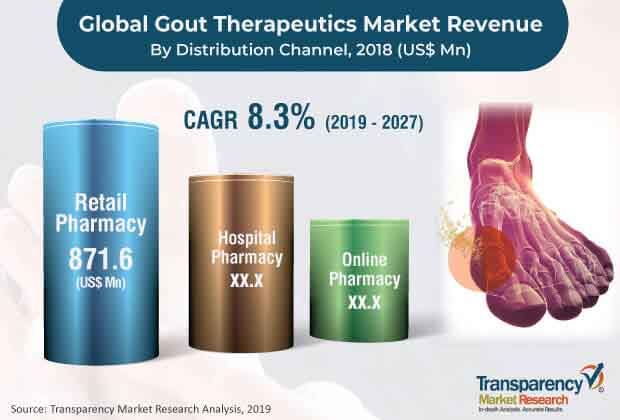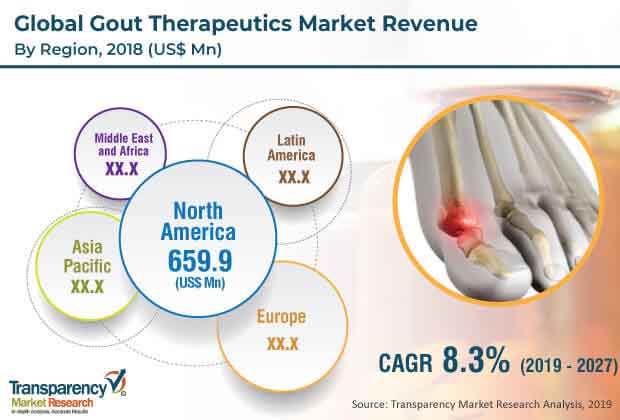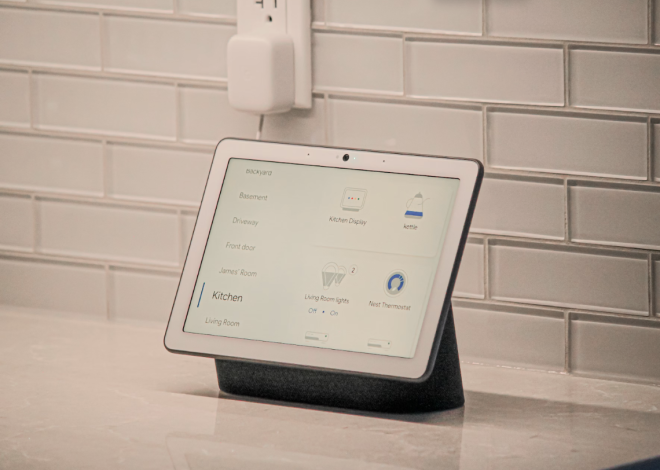
Gout Therapeutic Market – Global Industry Analysis, Size, Share, Growth, Trends, and Forecast, 2019 – 2027
The global gout therapeutic market is driven by high prevalence and rapid increase in incidence of gout arthritis across the globe. The global gout therapeutics market was valued at US$ 1874 Mn in 2018 and is projected to reach US$ 3820 Mn by 2027, expanding at a CAGR of 8.3% from 2019 to 2027.
High growth rate of the gout therapeutics market is attributed because of following factors
- Increase in drug pipeline
- Easy availability,
- Rise in the demand for biologics for treatment of gout across the globe.
Gout is a type of inflammatory arthritis caused by small crystals of a chemical called uric acid that form in the joints. If uric acid levels in the blood remain elevated, thin rod-like crystals can form and deposit in the joints, which can lead to severe pain, tenderness, stiffness, swelling, and joint damage.
Gout has both active and inactive periods. Active periods of gout are known as ‘attacks’ and can vary in severity and length. Diagnosis of gout is confirmed by synovial fluid analysis. Incidence of gout has been rising consistently over the last few years.
- According to Nationwide Emergency Department Sample (NEDS), total number of ED visits per year among patients with a primary diagnosis of acute gout increased 26.8% between 2006 and 2014; from 168,580 to 213,780.
Traditional therapies are witnessing a shift toward biologics. Rise in demand for effective treatment and new therapeutics launches are projected to propel the global gout therapeutics market during the forecast period. Efforts are being taken in various countries to spread awareness about chronic diseases and role of biologics in treating gout among the general population.
The global gout therapeutic market has been segmented based on drug type, distribution channel, and region. In terms of drug type, the gout therapeutics market has been classified into NSAIDS, colchicine, corticosteroids, antihyperuricemic agents (urate-lowering drugs), and biologics. The antihyperuricemic agents (urate-lowering drugs) segment dominated the gout therapeutics market in 2018.
Request Sample Of Report – https://www.transparencymarketresearch.com/sample/sample.php?flag=S&rep_id=66875
The segment is projected to expand at a high CAGR from 2019 to 2027. Biologics have witnessed rapid adoption and are replacing NSAIDS and corticosteroids owing to better results. Hence, the biologics segment is anticipated to expand at a rapid pace and is likely to gain gout therapeutics market share during the forecast period.
Antihyperuricemic agents (urate-lowering drugs) are usually prescribed as the first line of treatment. Moreover, adoption and success of Target-2-Treat (T2T) strategy using a combination of biologic and conventional synthetic urate-lowering drugs for the treatment of severe gout disease are key factors fueling biologic and antihyperuricemic agents segments.
Based on distribution channel, the global gout therapeutics market has been categorized into hospital pharmacy, retail pharmacy, and online pharmacy. The retail pharmacy segment accounted for major share of the global market in 2018, followed by hospital pharmacy and online pharmacy segments.
Request the Coronavirus Impact Analysis on this Market – https://www.transparencymarketresearch.com/sample/sample.php?flag=covid19&rep_id=66875

Increase in the number of multinational hospitals and preference to take injectable biologic drug products at hospitals is estimated to drive the hospital pharmacy segment.
- Increasing number of hospitals in developing countries, such as India China, Singapore, and Malaysia is further fueling the segment.
In terms of region, the global gout therapeutics market has been segmented into North America, Europe, Asia Pacific, Latin America, and Middle East & Africa. North America accounted for significant share of the global market in 2018, followed by Europe.

Well-established health care facilities, favorable reimbursement policies, and early adoption of therapeutics for the treatment of gout contributed to the high gout therapeutics market share held by North America. Europe is projected to be the second-most attractive market for gout therapeutics from 2019 to 2027.
The gout therapeutics market in the Europe is anticipated to expand at a high CAGR during the forecast period, due to high prevalence and increase in incidence of gout and high per capita health care expenditure in the region.
Buy this Research Report Now – https://www.transparencymarketresearch.com/checkout.php?rep_id=66875<ype=S
The global gout therapeutics market is consolidated, with several companies accounting for majority market share. Key players operating in the global market include Takeda Pharmaceutical Company Limited, Teijin Pharma Limited., Novartis AG, Mylan N.V., and Horizon Pharma plc. These players exhibit significant geographic outreach, with presence in multiple gout therapeutics segments.
Manufacturers are adopting acquisition & collaboration and new product development strategies to tap the unmet needs of a large proportion of patient pool. Other prominent players in the global gout therapeutics market include Teva Pharmaceutical Industries Ltd., Hikma Pharmaceuticals PLC, Iroko Pharmaceuticals, LLC, and MERCK & CO., Inc.
More Trending Reports by Transparency Market Research – https://www.biospace.com/article/exocrine-pancreatic-insufficiency-epi-therapeutics-and-diagnostics-market-increase-in-prevalence-of-chronic-pancreatitis-and-cystic-fibrosis-propel-global-market/


